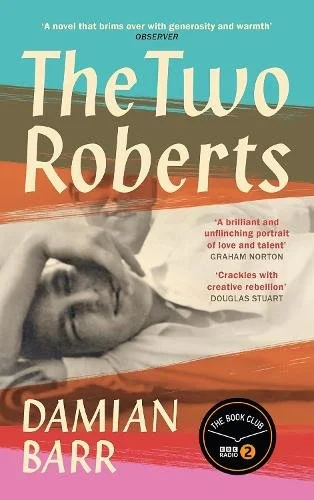I enjoy it when immersive historical fiction introduces me to fascinating individuals from the past. It inspires me to want to find out more about them. Damian Barr's new novel “The Two Roberts” recreates the lives of Bobby MacBryde and Robert Colquhoun, two working class gay Scottish artists who came of age in the mid 20th century. They climbed the heights of British society and moved in the artistic circles of the time before disappearing into relative obscurity. This is a deeply-involving, thought-provoking and sexy tale! I was a big fan of Barr's debut novel “You Will Be Safe Here” so it was great to discover that this new book explores a different corner of queer history.
A slight concern I had before starting this novel was whether I'd confuse the central characters since they are both called Robert. But the distinctions between Bobby and Robert are made very clear from the beginning. Though there are superficial similarities between them there are many differences regarding their personalities, artistic subjects, religious backgrounds and erm... sexual preferences. I got so involved following the tensions of their relationship, painterly aspirations and immersion in their society. Despite having to live under the persistent fear of potential arrest just from having gay sex it didn't stop them collecting buttons from their heated encounters with many different men. They were deeply devoted to each other as a couple but there was also a lot of messiness and broken crockery in their entwined lives. Amorous letters and sketches of each other needed to be destroyed because they could have been used as evidence against them. So it's poignant how the vanished intimate details of their lives are reimagined in the story. This novel gives a multi-layered look at the challenges as well as the vibrancy and excitement of queer life at this time.
Naturally, I loved how Bobby discovers a deep passion for reading in his local library. His enthralment with studying paintings in books makes his and Robert's first journey to a London gallery to see some of these artworks in person all the more thrilling. It inspired me to take a trip to The National Gallery in London to see for myself Van Gogh's Sunflowers which this pair once examined together. I show footage from my solo expedition in a video I've made about this novel. It's interesting how their artistic development and collaboration is shown in the novel as well as their acquaintance with figures such as Lucian Freud and Elizabeth Smart (as well as tensions they had with Vanessa Bell and the Bloomsbury Group.) Damian Barr has also curated a new exhibition of MacBryde and Colquhoun's paintings at Charleston in Lewes so I hope to see that at some point before it closes in April.


























